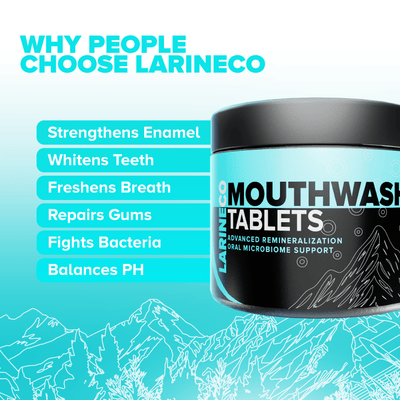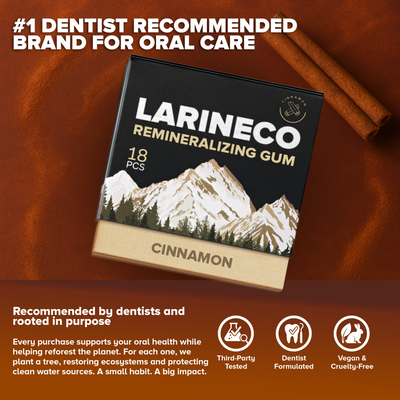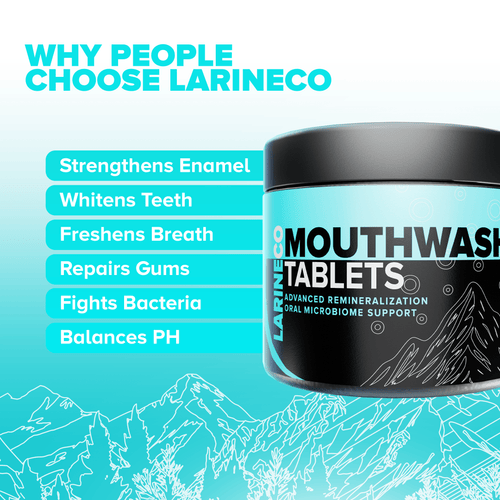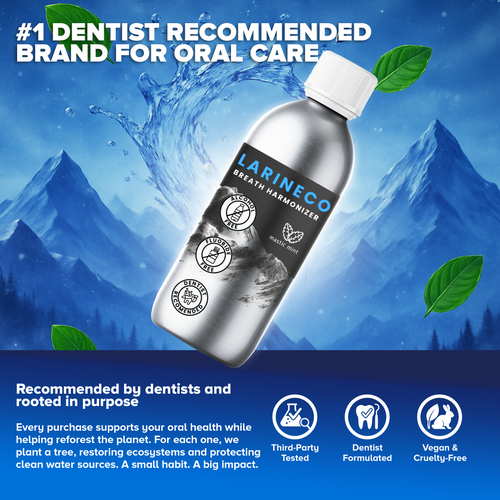The Ultimate Whitening Combo: Hydroxyapatite + Activated Charcoal + Terpenes
Why Conventional Whitening Damages Your Teeth
The Problem with Peroxide and Abrasive Whitening Agents
Most over-the-counter whitening products rely on hydrogen peroxide or carbamide peroxide to bleach stains. These chemicals penetrate the enamel to oxidize pigments in the dentin, the layer beneath your enamel. While effective at altering tooth color, they don’t differentiate between pigment and protein. This means they also break down the organic components of your tooth structure, weakening it over time.
In addition, many whitening toothpastes use abrasives like silica or baking soda to scrub away surface stains. The problem? These particles don’t just remove stains; they also wear down enamel, your teeth’s natural protective barrier.
Sensitivity and Enamel Erosion: A Hidden Cost
The harsh reality is that conventional whitening doesn't just remove stains, it can also strip away enamel. Once enamel is worn down, it doesn't grow back. As a result, dentin becomes exposed, leading to increased tooth sensitivity, especially to hot or cold food and drinks. This discomfort is a red flag that your teeth are vulnerable. Enamel erosion also makes teeth more porous, duller in appearance, and prone to future staining, a self-defeating cycle.
The Search for a Gentle, Effective Alternative
Consumers are becoming more aware of the trade-offs of conventional whitening and are looking for solutions that don’t sacrifice long-term health for short-term aesthetics. A truly effective whitening product should enhance brightness while also protecting and strengthening enamel. This is where new-generation ingredients like nano-hydroxyapatite, activated charcoal, and plant-based terpenes come in. These alternatives whiten gently, support remineralization, and help maintain the integrity of your enamel, solving the problem without causing new ones.
The Science Behind a Smarter Whitening Solution
Hydroxyapatite rebuilds and smooths enamel, filling micro-cracks where stains hide. Activated charcoal lifts surface stains by adsorbing pigments without scratching. Terpenes, plant-based compounds, fight bad bacteria and freshen breath naturally. Together, they brighten teeth gently while strengthening and protecting enamel.
Hydroxyapatite: Whiten and Repair at the Same Time
Rebuilds Enamel with Biomimetic Precision
Hydroxyapatite (HA) is the primary mineral that makes up human enamel. Synthetic nano-hydroxyapatite mimics this structure with near-identical composition and size, allowing it to bind seamlessly to enamel and dentin. When applied topically, it fills micro-fissures, covers exposed dentinal tubules, and reinforces weak spots. This not only protects against future damage but begins a regenerative process remineralizing from the outside in, unlike whitening agents that strip enamel away.
Naturally Reflects Light for a Brighter Appearance
Unlike peroxide whiteners that bleach tooth color by oxidizing stains (and sometimes enamel), hydroxyapatite restores the tooth’s surface integrity, making it smoother and more reflective. The result? Teeth appear brighter not because they’re artificially whitened, but because they’re healthier and structurally intact. The improved surface quality enhances light reflection, delivering a natural, radiant white without over-sensitizing the teeth.
Clinically Proven to Reduce Sensitivity
Multiple studies show that nano-hydroxyapatite is effective at reducing dental sensitivity. It works by sealing off exposed dentinal tubules, tiny channels that lead to the tooth nerve, thereby blocking pain signals triggered by heat, cold, or pressure. This dual-action whitening and desensitizing makes it ideal for people with sensitive teeth who have been excluded from conventional whitening solutions. You're not just masking sensitivity; you're fixing the cause.
Activated Charcoal: Nature’s Gentle Detoxifier
Adsorbs Stains Without Damaging Enamel
Activated charcoal is known for its powerful adsorptive capacity, meaning it binds to and lifts particles rather than scratching them off. This makes it especially effective at removing surface stains caused by coffee, tea, wine, or smoking, unlike abrasive whitening powders or toothpaste that grind down enamel. Activated charcoal works by clinging to stain-causing compounds and gently lifting them away. When finely milled and properly formulated, it polishes rather than erodes, offering a safer path to whiter teeth for daily or frequent use.
Removes Surface Plaque and Toxins
Beyond stain removal, charcoal also binds to unwanted elements like plaque biofilm, bacterial byproducts, and toxins that accumulate on the teeth and gums. Its porous structure gives it a massive surface area that acts like a sponge, soaking up harmful substances before they cause damage or contribute to bad breath. This makes charcoal a useful addition not just for cosmetic whitening, but for detoxifying the entire oral environment, supporting fresher breath, cleaner enamel, and healthier gums.
Myths vs. Reality: Is Charcoal Safe for Daily Use?
There’s a lot of hype and concern around charcoal. Critics often point to the dangers of over-abrasion, but not all charcoal products are created equal. The key difference lies in particle size and formulation. Poorly formulated charcoal toothpaste can indeed be harsh, but finely ground, pH-balanced charcoal blended with remineralizing ingredients (like hydroxyapatite) is both safe and effective. Clinical reviews support its safety when used correctly and in moderation. When integrated thoughtfully, activated charcoal is not a trend; it’s a science-backed tool for natural whitening and oral detox.
Terpenes: The Botanical Boost Your Smile Needs
What Are Terpenes and Why Do They Matter in Oral Care
Terpenes are aromatic compounds found in plants responsible for the distinct scents of citrus, mint, pine, and herbs. But their value extends far beyond fragrance. In oral care, terpenes serve as bioactive agents with functional benefits. When derived from botanicals like peppermint, eucalyptus, or tea tree, they contribute therapeutic properties that go beyond just making your toothpaste smell nice. These small, lipophilic molecules can penetrate tissues and support the delivery of other active ingredients like hydroxyapatite and essential oils. In essence, terpenes are nature’s delivery agents, making your oral care not only smell and taste better but work harder.
Antimicrobial & Anti-inflammatory Properties
Certain terpenes have been studied for their antimicrobial, antifungal, and anti-inflammatory effects. For example, limonene (from citrus), menthol (from mint), and eucalyptol (from eucalyptus) have all been shown to inhibit oral pathogens like Streptococcus mutans, a major contributor to tooth decay and plaque. At the same time, these compounds help calm inflamed or irritated gum tissue, reducing redness and promoting healing. Unlike synthetic antiseptics that disrupt the oral microbiome, terpenes can selectively target harmful bacteria while supporting a healthy balance, offering a more nuanced, natural approach to oral defense.
Enhances Freshness and Bioavailability of Actives
Terpenes don’t just fight bacteria; they elevate the entire oral care experience. Their volatile nature makes them effective at neutralizing odors and leaving a clean, fresh mouthfeel that lasts longer than artificial flavorings. But even more importantly, some terpenes act as “penetration enhancers,” improving the absorption and effectiveness of other active ingredients like nano-hydroxyapatite. They help these molecules reach deeper into enamel pores or soft tissue, making remineralization and gum repair more efficient. This synergy turns a good oral formula into a great one, amplifying both short-term freshness and long-term results.
Synergy in Action: Why This Trio Works Better Together
Whitening + Remineralization + Detox = Long-Term Oral Health
Most whitening products focus on appearance, temporarily removing stains at the cost of long-term damage. This trio, Hydroxyapatite, Activated Charcoal, and Terpenes, goes further. Hydroxyapatite rebuilds and strengthens enamel at a microscopic level. Activated charcoal lifts surface stains and binds to toxins. Terpenes fight harmful microbes and reduce inflammation. Used together, they create a multi-layered defense: one that whitens, heals, and protects. Instead of a quick fix, you’re building a healthier foundation for long-term oral resilience.
Balances the Oral Microbiome While Enhancing Aesthetics
Harsh whitening agents often disrupt the oral microbiome, killing off both harmful and beneficial bacteria. This imbalance can lead to sensitivity, bad breath, and even gum disease. The charcoal-terpene-HA combination avoids that trap. Charcoal absorbs plaque without scrubbing away good bacteria. Terpenes selectively target pathogenic microbes while calming soft tissue. Hydroxyapatite supports a strong enamel barrier that naturally resists acid and bacterial attack. Together, these ingredients strike a rare balance: functional beauty with biological integrity. The result? A smile that’s not only whiter but stronger, healthier, and more sustainable.
Clean Whitening Without Compromise
Skip the fluoride, sulfates, and harsh whiteners. Most mainstream products irritate gums, dry out your mouth, and worsen sensitivity. This formula takes a different path, powered by hydroxyapatite, activated charcoal, and botanical terpenes to whiten, detox, and remineralize gently and effectively.
Backed by science, not trends, each ingredient is proven to support long-term oral health without pain or side effects. It's safe enough for daily use, even for sensitive teeth. No gimmicks. No damage. Just clean, clinically grounded whitening that works with your biology, not against it.
Final Thoughts: A Whitening Routine That Heals, Not Harms
Traditional whitening strips, pastes, and peroxide gels focus on quick fixes, often at the expense of your enamel and oral microbiome. But a new class of oral care is emerging, one that does more than whiten. Hydroxyapatite, activated charcoal, and terpenes work synergistically to rebuild enamel, remove stains, and support gum health, all without the trade-offs of sensitivity or damage.
A truly radiant smile isn’t just white, it’s strong, balanced, and inflammation-free. This trio-powered approach doesn’t just mask problems; it addresses them at the root. By choosing a whitening system that supports your biology, you’re investing in the long-term health and natural beauty of your teeth. Because the best kind of white is the one that lasts and heals.










